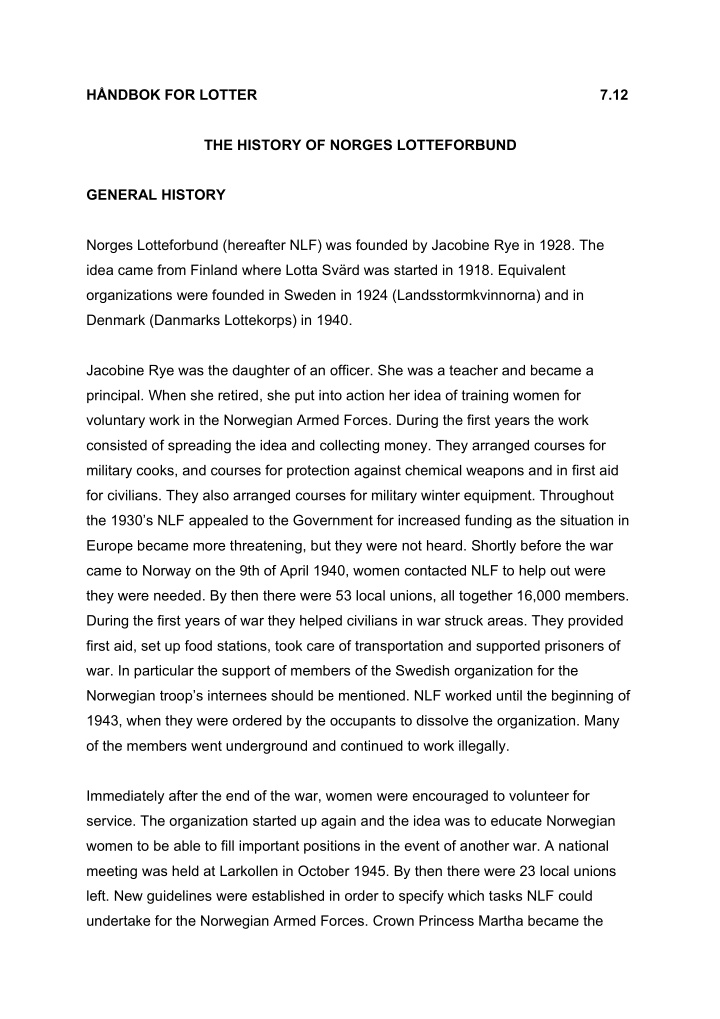



HÅNDBOK FOR LOTTER 7.12 THE HISTORY OF NORGES LOTTEFORBUND GENERAL HISTORY Norges Lotteforbund (hereafter NLF) was founded by Jacobine Rye in 1928. The idea came from Finland where Lotta Svärd was started in 1918. Equivalent organizations were founded in Sweden in 1924 (Landsstormkvinnorna) and in Denmark (Danmarks Lottekorps) in 1940. Jacobine Rye was the daughter of an officer. She was a teacher and became a principal. When she retired, she put into action her idea of training women for voluntary work in the Norwegian Armed Forces. During the first years the work consisted of spreading the idea and collecting money. They arranged courses for military cooks, and courses for protection against chemical weapons and in first aid for civilians. They also arranged courses for military winter equipment. Throughout the 1930’s NLF appealed to the Government for increased funding as the situation in Europe became more threatening, but they were not heard. Shortly before the war came to Norway on the 9th of April 1940, women contacted NLF to help out were they were needed. By then there were 53 local unions, all together 16,000 members. During the first years of war they helped civilians in war struck areas. They provided first aid, set up food stations, took care of transportation and supported prisoners of war. In particular the support of members of the Swedish organization for the Norwegian troop’s internees should be mentioned. NLF worked until the beginning of 1943, when they were ordered by the occupants to dissolve the organization. Many of the members went underground and continued to work illegally. Immediately after the end of the war, women were encouraged to volunteer for service. The organization started up again and the idea was to educate Norwegian women to be able to fill important positions in the event of another war. A national meeting was held at Larkollen in October 1945. By then there were 23 local unions left. New guidelines were established in order to specify which tasks NLF could undertake for the Norwegian Armed Forces. Crown Princess Martha became the
patron of the organization. When she died in 1954, her daughter Princess Astrid Mrs. Ferner became patron, a position she still holds. The Norwegian Home Guard (Heimevernet, hereafter HV) started to take shape in 1946 and some local unions of NLF had already been in contact with local HV leagues. The big question in 1947 was whether there should be a compulsory military service for women. The National Meeting of NLF was against compulsory service for women, but in favor of work duty for women in a war situation. An agreement regarding cooperation between NLF and HV was signed on the 31 st of October in 1947. Agreements with the navy and air forces were signed in 1951. From the 1 st of July in 1951, NLF has received financial support from the Government. The support is used for promotion, and for education of members. After signing the agreements with the various forces/HV, NLF’s members received special training and signed personal service agreements. In accordance with the government proposition of 1957, it was decided that members with signed service agreements should be equal to other voluntary personnel in the Norwegian Armed Forces and would be titled “reserve personnel.” In 1987 the inspector general in HV founded a committee to find a new definition of the services of NLF members. As a result of the committee’s work, the Government voted in favor of a new definition. NLF members were now able to sign personal agreements which allowed them to be enrolled in battle in the event of war. In 1977 there was a prediction of restructuring of the Norwegian Armed Forces, and that NLF’s participation could change and the cooperation with the Norwegian Directorate for Civil Protection (DSB) was increased and the concept Total Defense was introduced. An agreement was signed in 1995 between DSB and voluntary organizations, including NLF. The main reason for these agreements is that the organizations leaders and personnel should receive relevant education according to a specific plan based on evaluation of risk and analysis of consequences. At the National Meeting of 2019, NLF was opened for male members.
THE ORGANIZATION To become a member of NLF you have to be at least 16 years of age and undertake NLF Introduction Course. If members wish to sign an agreement with the Norwegian Armed Forces, they need to undertake GSU (basic soldier education) at HVSKS (Heimevernets skole- og kompetansesenter) at Dombås. Other courses NLF offers its members include for example: Presentation Technique Course, Instructor Course, Leadership Course and other military related courses. NLF’s members also have access to courses in other organizations. NLF’s highest authority is the National Meeting which is held every other year, where the board is elected. The board consist of the chairman, deputy chairman, and board members for information and recruiting and education. Like HV, NLF is divided into 11 districts. Each district has local unions, all together 13 consisting of 500 members. The local unions have their own boards. NLF is also involved with other organizations that support the Norwegian Armed Force. These organizations also give courses and conferences on the topics of Norwegian Defense Policy. The threats towards our nation are not the same as previously. We have to constantly assess our situation in view of a changing world. One of the main task of the Norwegian Armed Forces today is cooperation between military and civil organizations. NLF has great expectations for the future. We have a large network and we are growing. We are a nonpolitical voluntary organization and we need members of all ages with different backgrounds and educations. We train so that we can be equipped and prepared to take our part of responsibility in any crisis the country or local areas may be faced with. November 2004
Revidert juni 2020 Godkjent av vedtektskomité juni 2020
Recommend
More recommend